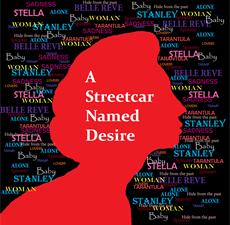A Streetcar Named Desire | Liverpool Performing Arts Ensemble
- November 5th, 2013
- Posted in Reviews & Responses . Uncategorized
- Write comment

A Streetcar Named Desire… a portrait of American working class life? A momentary glimpse of a life off the rails? An exploration of feminine and masculine role play? A poetic examination of power?
A classic play pumped up full of theatrical mythology – poking its head through the curtain of time and whispering in our post modern ears that it’s always “depended on the kindness of strangers” or screams out in hard and primal desperation “Stella!” The references to Williams’ play slide and slip across the world, across culture and into our back pockets. So well worn we can nearly take it for granted, that it is there.
The essence of the play’s emotional world is still affecting – domestic violence, homosexuality and suicide, mental health, poverty.
In contrast to the last Streetcar I experienced – the glossy elevated stage of the Sydney Theatre, Cate Blanchett a fluttering, playful moth to the flame – The LPAE version stings and satisfies in a different way. This is not a production focused on quaint voyuerism of another time and place. Something rumbles in the gut of this production. Authentic hunger? Frustration?
In the STC Streetcar I saw a portrait of fragility which was well pampered: Blanchette in all her celebrity glory, already soaked in the soft-skinned ease of that particular production. A grand and monolithic set overwhelming the tiny humans on that huge stage.
In this production, the proximity of audience to the quarter, the humble, functionary set and decor – the actors overwhelming the space with voice and action – adding something particular to this Streetcar experience.
When a story is told, the time and place it is told is greeted with a resonance of that particular context. As Heraclitus could not step into the same river twice, nor can an audience see the same play twice. The context making the telling different, by virtue of time passed, experience gained. Audiences bring their context and it ebbs and flows between their personal memory and the current experience onstage.
Directed by Jacqueline Hornjik and Peter Hornjik, Williams’ Streetcar is difficult handful of scenes. As each character, like a game of seven card stud, reveals their face and their worth we soon become aware of the culmination of a mighty and unstoppable mess. In the final minutes when lives are redefined (or restored?)a card game floats above the action and lingers whispering “regardless the men continue as they do, playing a game… calling the shots.”
The difficult thing with all Streetcar’s performed in Australia is that naturalism easily slips into a heightened form of performativity – Australian actors performing in accent have additional layers to naturalise within themselves, not just time but culture and language, place and voice. And this is where clarity of voice and action become so important – and clarity is not to be mistaken for “obvious.” The unnatural realm of the theatre needs to be naturalised enough so that lust, desire, sexual tension are borne out of the situation of the characters, not the situation of the actors… and some in the LPAE production find this easier than others. This is an approximation of realism – one which relies on the internal world of the actor to be finely tuned, senses accutely aware.
As each character, in each scene, plays the hand their given – a sick mother, a screaming wife, a thuggish husband, an administrative interrogation – a new reason for action is presented. A challenge of authority? The Napoleonic code? A need to be loved? A need to take care of/be taken care of? Security? Passion?
And what do we learn from a Stanley (William Koutsoukis) so consumed with anger his teeth would snap and crunch through a chicken bone with animalistic urge at dinner? That the rage and emotional world of Stanley is so much more honest and immediate than that of Blanche (Christine Graf) who lightly flutters claiming “nerves.” And what do we learn of the dull and dutiful Stella (Kate Engelfield) perhaps she has more patience for Blanche than any of us can stomach or understand (and an ability to supress her primal urge to be entangled with the meat and muscle of Stanley?). And perhaps we learn that Mitch (John Knauss) despite his army training is kinder to the light (and the lantern) than we’d assume of a colleague and friend of Kowalski.
The major questions come flooding to me about forgiveness, redemption in the face of someone we love, know or are related to shows themselves to be something new or other than what we know or expect. The danger comes not in the action of the characters – but the potential action. Where the action is restrained and muted, we lean forward in anticipation.
This is Stanley’s world of control and dominance, where his silence is a ticking time bomb humming under the effusive gush of Blanche. This is Stanley’s world of order and rank. Where things work or they don’t. They’re true or they’re not. Such a world leaves no room for Blanche’s fanciful watercolour reflections. And why should it? Does it now? Does it ever?
What surprised me in this production is the casual ease tempers flair and violence is ignored – showing me to be still sensitive to the clashes and collisions. I’m grateful to this production for that reminder.